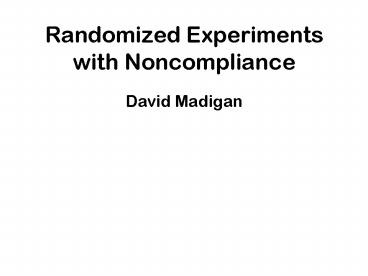Randomized Experiments with Noncompliance PowerPoint PPT Presentation
1 / 30
Title: Randomized Experiments with Noncompliance
1
Randomized Experiments with Noncompliance
- David Madigan
2
Introduction
- Noncompliance is an important problem in
randomized experiments involving humans - Includes e.g. switching subjects to standard
therapy when experimental therapy fails - Intent-to-treat (ITT) is a standard approach
and is endorsed by FDA, journals, etc. - Analyzes the data as-randomized
3
ITT
- Analyses that include all randomized patients in
the groups to which they were randomly assigned,
regardless of their compliance with the entry
criteria, regardless of the treatment they
actually received, and regardless of subsequent
withdrawal from treatment or deviation from the
protocol. - Workgroup for the Biopharmaceutical Section of
the American Statistical Association
4
ITT
- Simple
- Encourages complete follow-up
- Estimates use-effectiveness? (Many protocol
deviations mirror events that would happen in
normal medical practice? Protease inhibitors?) - Conservative (but not for equivalence studies)
5
CPCRA Oral Ganciclovir Study
- 40 of AIDS patients get CMV retinitis
- Ganciclovir is the standard treatment (1994)
- Oral ganciclovir as a prophylactic intervention
for CMV retinitis in HIV/AIDS - NIH-funded, double-blind, placebo-controlled
randomized study, n994 - September, 1995, The Lancet
6
(No Transcript)
7
CPCRA Oral Ganciclovir Study (cont.)
- Syntex study completed in early 1995 showed 49
reduction in CMV retinitis - CPCRA study allowed placebo subjects to take oral
ganciclovir - Analysis was by ITT
- 2.1 months in placebo arm versus 9.3 months in
the treatment arm
8
Naïve Alternatives to ITT
- as-treated
- per-protocol
- censored method
- transition method
Depending on the relationship between compliance
and outcome, these can all be biased.
No simple solution to this complex problem!
9
Fictituous Study
- Randomized study comparing T and C
- YT or YC known for all subjects
- All C patients comply
- Some T patients revert to C early in the study
due to toxicity - Ts toxicity is less tolerable to sicker patients
10
ITT
- Dilutes the T effect with patients who did not
take T - Downward bias in estimation of the T effect
- What are the expected outcomes for a typical
patient instructed, in the course of a clinical
trial, to take the treatment to which he/she was
assigned?
11
Per Protocol
- Estimates the T effect from a group stripped of
poorer prognosis patients - Upward bias in estimation of the T effect
- What are the differences between average T
outcomes for patients who choose to adhere to
recommended treatment T and outcomes for patients
who choose to adhere to recommended treatment C?
12
As-Treated
- Assigns the non-compliers to C
- Strips T of poor prognosis patients
- Upward bias in estimation of the T effect
- What are the differences between average
outcomes for patients who take T as compared to
those who take C, where the C group contains more
patients with poor prognosis?
13
Rubin Causal Model
Yi(j) health outcome (e.g. survival) for
subject i if assigned to treatment j,
j1,2 SUTVA ITT causal effect of assignment for
subject i Yi(1)-Yi(0) Average ITT Causal
Effect S(Yi(1)-Yi(0))/N Fundamental Problem of
Causal Inference
14
Confounding
15
Stratification can Introduce Confounding
16
Stratification can Introduce Confounding
17
Rubin Causal Model
Di(j) treatment outcome for subject i if
assigned to treatment j, j1,2
Di(0), Di(1), Yi(0), Yi(1) Complier, if
Di(0)0 and Di(1)1 Never-taker, if Di(0)0 and
Di(1)0 Always-taker, if Di(0)1 and Di(1)1
Defier, if Di(0)1 and Di(1)0
18
Rubin Causal Model
Complier Average Causal Effect (CACE)
ave(Yi(1)-Yi(0) Di(0)0 and Di(1)1)
For compliers, can attribute the effect on Y of
assignment to treatment to the effect of receipt
of treatment?
19
Common Assumptions
(Weak) Exclusion Principle Yi(1) Yi(0)
for all i such that Di(1) Di(0) Monotonicity
Di(1) ? Di(0) for all i, with inequality for
at least one
subject.
20
Vitamin A Example
- Villages in Northern Sumatra
- Receive or not to receive vitamin supplements for
a one-year period
21
(No Transcript)
22
(No Transcript)
23
0.28
0.01
0.68
0.03
24
Educational Experiment
25
(No Transcript)
26
(No Transcript)
27
Conclusion
- The intent-to-treat proposal is too simple for
the diverse ways in which treatment can be used
and in which plans for treatment can be violated - The Rubin Causal Model provides an
alternative/supplemental mode of analysis - Dawid (1997) has challenged the philosophical
basis
28
Pr(M)
29
0.28
0.01
0.68
0.03
30
CACE 95 HPDs
M2
M3
M1
M0
BMA

